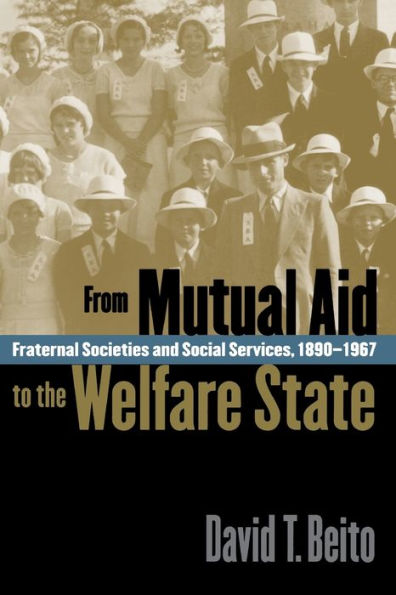Table of Contents
Acknowledgments
Abbreviations Used in the Text
Introduction
Chapter 1. This Enormous Army
Chapter 2. Teaching Habits of Thrift and Economy
Chapter 3. Not as Gratuitous Charity
Chapter 4. The Child City
Chapter 5. From the Cradle to the Grave
Chapter 6. The Lodge Practice Evil Reconsidered
Chapter 7. It Almost Bled the System White
Chapter 8. It Substitutes Paternalism for Fraternalism
Chapter 9. Our Dreams Have All Come True
Chapter 10. Our Temple of Health
Chapter 11. The End of the Golden Age
Chapter 12. Vanishing Fraternalism?
Notes
Bibliographic Essay: Sources on Fraternalism and Related Topics
Index
Tables
2.1. Lodge Membership among Wage Earners in New York City
2.2. Lodge Membership among Wage Earners in New York City with Family Incomes between $600 and $799
2.3. Fraternal Life Insurance among a Sample of Wage-Earning Male Heads of Families in Chicago
2.4. Life Insurance Ownership in a Sample of Wage-Earning Families in Chicago
4.1. Occupations of the Fathers of Children at Mooseheart and Adult Males in Illinois
4.2. Decisions by the Board of Governors on Applications for Admission to Mooseheart
4.3. Status of Families Admitted to Mooseheart
4.4. Decisions by the Board of Governors on Applications for Demission from Mooseheart
4.5. Average Weekly Wages, Mooseheart Graduates, 1919-1929, and All Male and Female Wage Earners in the United States, 1930
5.1. Family Status of Children Admitted to the SBA Children's Home
5.2. Pre-Orphanage Backgrounds of Alumni
5.3. Overall Assessments of Orphanage Stay
5.4. Personal Preference for Way of Growing Up
5.5. Positive Attributes Cited
5.6. Negative Attributes Cited
5.7. Median Household Incomes of U.S. General White Population (65 years and older) and Orphanage Respondents
5.8. Educational Background and Divorce Rates of U.S. General White Population (65 years and older) and Orphanage Respondents
10.1. Death Rates and Average Length of Stay: Taborian Hospital and Friendship Clinic
10.2. Death Rates and Average Length of Stay: Black and White Patients in Fifty-three General Hospitals in South Carolina
11.1. Death, Permanent Disability, Sickness and Accident, Old-Age, and Other Benefits for 174 Fraternal Societies: Annual Amount Paid, 1910, 1920, and 1930
11.2. Death, Permanent Disability, Sickness and Accident, Old-Age, and Other Benefits for 174 Fraternal Societies: Spending per Member, 1910, 1920, and 1930
11.3. Death, Permanent Disability, Sickness and Accident, Old-Age, and Other Benefits for 174 Fraternal Societies as Percentage of All Losses Paid, 1910, 1920, and 1930
11.4. Payment of Benefits for Permanent Disability, Sickness, Accident, and Old Age in 174 Fraternal Societies: Percentage of Societies Offering, 1910, 1920, and 1930
12.1. Death, Permanent Disability, Sickness and Accident, Old-Age, and Other Benefits for 174 Fraternal Societies: Annual Amount Paid, 1930, 1935, and 1940
12.2. Death, Permanent Disability, Sickness and Accident, Old-Age, and Other Benefits for 174 Fraternal Societies: Spending per Member, 1930, 1935, and 1940
12.3. Death, Permanent Disability, Sickness and Accident, Old-Age, and Other Benefits for 174 Fraternal Societies as Percentage of All Benefits, 1930, 1935, and 1940
12.4. Payment of Benefits for Permanent Disability, Sickness, Accident, and Old Age in 174 Fraternal Societies: Percentage of Societies Offering, 1930, 1935, and 1940
12.5. Fraternal Homes for the Elderly, 1929 and 1939
12.6. Fraternal Orphanages, 1923 and 1933
IllustrationsJohn Jordon Upchurch
Drill team of Camp 566, MWA
Bina M. West
Juvenile Division of the IOSL
Oronhyatekha
Macon Drill Corps, International Order of Twelve Knights and Daughters of Tabor
Examining room, Mooseheart Hospital
Girls' band, Mooseheart
Teachers, matrons, and children of the SBA Children's Home
Tuberculosis sanitarium of the MWA
Advertisement for the hospital program of the LOTM
Hospital of El Centro Asturiano
SBA Hospital
Taborian Hospital
Dr. T. R. M. Howard examining a patient
Patients waiting to see doctors at the Taborian Hospital






